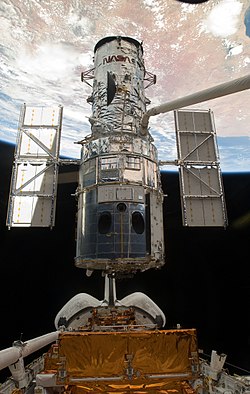Top Qs
Timeline
Chat
Perspective
SpaceCube
From Wikipedia, the free encyclopedia
Remove ads
SpaceCube is a family of high-performance reconfigurable systems designed[when?] for spaceflight applications requiring on-board processing. The SpaceCube was developed by engineers at the NASA Goddard Space Flight Center.[1] The SpaceCube 1.0 system is based on Xilinx's Virtex-4 commercial FPGAs. The debut mission of the SpaceCube 1.0, Hubble Servicing Mission 4, was the first time Xilinx's Virtex-4 FPGAs flew in space.[2]
Remove ads
Missions
- Hubble Servicing Mission 4: The SpaceCube was the brains of the Relative Navigation Sensors autonomous docking experiment that was intended to run in parallel with the astronaut controlled docking of the Hubble Space Telescope.[3] RNS met its stated goals.[4]
- MISSE-7: The SpaceCube was attached to the outside of the ISS during an EVA on Space Shuttle Mission STS-129 (Nov 2009). It provides an on-orbit test platform for demonstrating innovative radiation hardened by software techniques. It is mounted on the NRL's MISSE7 experiment which is attach to an ExPRESS Logistics Carrier.[5][6]
Remove ads
Family overview
- SpaceCube 1.0: Based on Xilinx's Virtex-4 commercial FPGAs.
- SpaceCube 1.5: Intermediate version of SpaceCube 2.0. Based on Xilinx's Virtex-5 commercial FPGAs. Scheduled to fly on sounding rocket flight in the fall of 2010.[7]
- SpaceCube 2.0: Currently[when?] under development with over $1 million in funding.[7] The SpaceCube 2.0 system is based around Xilinx's new radiation-hardened Virtex-5 FPGA.[7][8][needs update]
Remove ads
Awards
NASA's Goddard Space Flight Center SpaceCube team earned an honorable mention for the 2009 "IRAD Innovator of the Year" award.[9]
On-board science data processing achievements
- Synthetic Aperture Radar (SAR) results:
References
External links
Wikiwand - on
Seamless Wikipedia browsing. On steroids.
Remove ads


